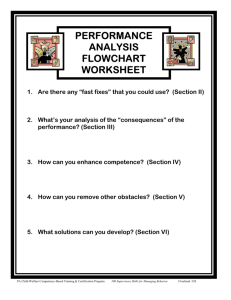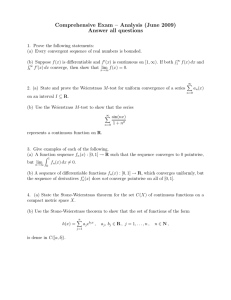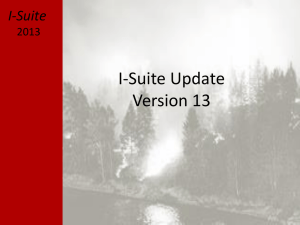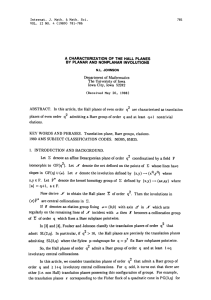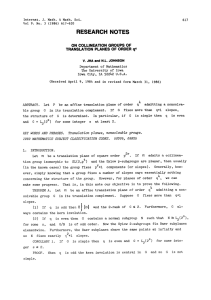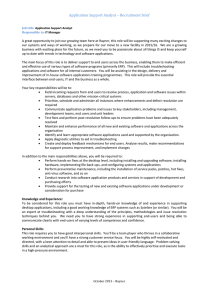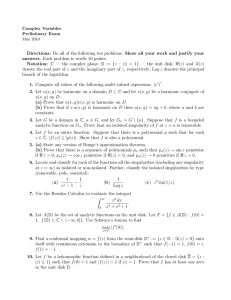q2 THE GL(2,q) IN EVEN
advertisement
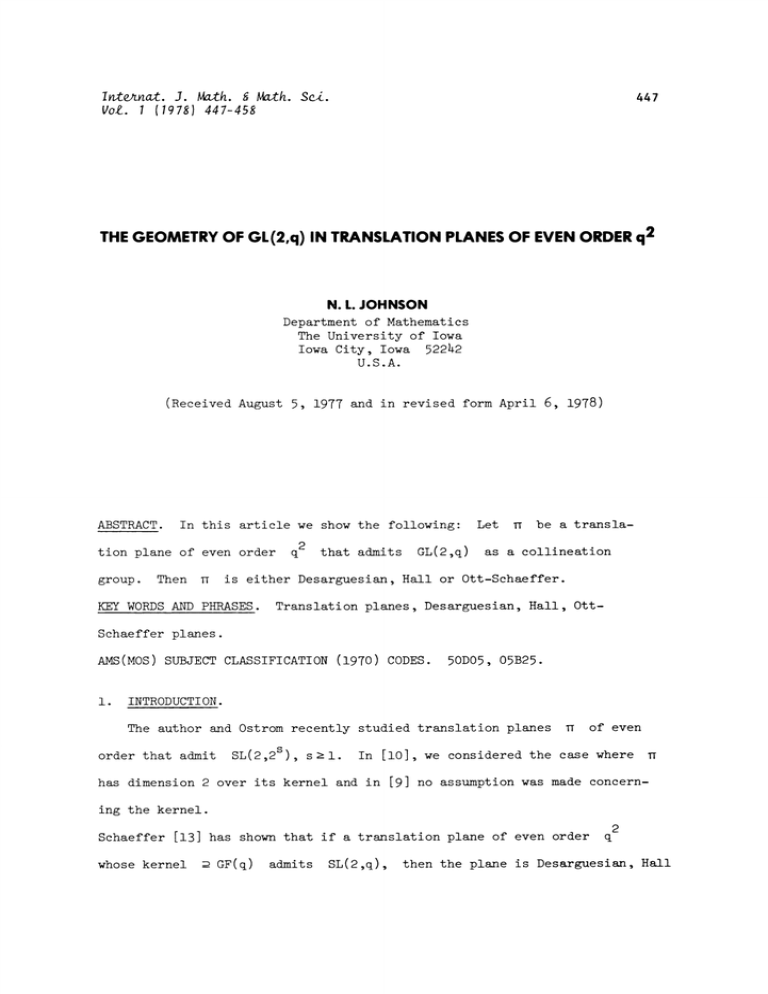
I nternat. J. Math. & Math. Sci. (1978)447-458 Vol. 447 THE GEOMETRY OF GL(2,q) IN TRANSLATION PLANES OF EVEN ORDER q2 N. L. JOHNSON Department of Mathematics The University of lowa lowa City, lowa 52242 U.S.A. (Received August 5, 1977 and in revised form April 6, 1978) ABSTRACT. In this article we show the following: tion plane of even order group. Then u q 2 GL(2,q) that admits Let II be a transla- as a collineation is either Desarguesian, Hall or Ott-Schaeffer. KEY WORDS AND PHRASES. Translation planes, Desarguesian, Hall, Ott- Schaeffer planes. AMS(MOS) SUBJECT CLASSIFICATION (1970) CODES. i. 50D05, 05B25. INTRODUCTION. The author and Ostrom recently studied translation planes order that admit SL(2,2 s), s>l. of even In [i0], we considered the case where has dimension 2 over its kernel and in _ II [9] no assumption was made concern- ing the kernel. Schaeffer [13] whose kernel has shown that if a translation plane of even order GF(q) admits SL(2,q), q 2 then the plane is Desarguesian, Hall 448 N. L. JOHNSON or 0tt-Schaeffer. In [9], it is shown that if the assumption on the kernel is dropped, the planes admitting SL(2,q) must have properties quite similar to the Desar- guesian, Hall or 0tt-Schaeffer planes but it is an open question whether such planes must, in fact, be in one of these three classes. In the dimension 2 situation, if the plane admits GL(2,2 s) also admits (see (2,2)). Schaeffer planes of even order q 2 SL(2,2 s) then the plane So, in particular, the Hall and Ottmust admit GL(2,q) as a collineation group. In this paper we observe that this situation can be reversed (see Theorem (.)). We assume the reader is familiar with the papers [9] and [i0]. 2. THE MAIN THEOREM. (2.1) NOTE. GF(2 s) is a translation plane of even order with kern If and admitting SL(2,2s), s >i, then T admits GL(2,2 s) as a collineation group. GL(2,2 s) =SL(2,2 s) PROOF. SL(2,2 s) K admits a group versely, if T then, by the obvious isomorphism, Since the kern homology group K (2.1)), (2.2) COROLLARY. whose kernel contains we have a group If w GF(q) 2S-l, GL(2,2s). is isomorphic to 2s-i comnmtes with elements and SL(2,2 s) is linear by [10] (see SL(2,2 s) K (since SL(2,2 s) is simple). of order is a translation plane of even order admits Con- where K is cyclic of order SL(2,2 s) K of the linear translation complement the proof of GL(2,2 s). where $ is the center of SL(2,2 s) s> I, then w 22r=q2 admits GL(2,2s). PROOF. group s (of lr by [i0] ((2.2) the group of kern have the proof to (2.2). and (2.4)). Thus, there is a cyclic sub- homologies) of order 2S-l. By (2.1), we 449 GEOMETRY IN TRANSLATION PLANES We also note that (2.2) is not valid for translation planes of odd order (see [4]). Foulser If a translation plane is of dim 2 then the group in the linear SL(2,2 s) translation complement generated by all Baer involutions is always if there are no elations and the group is nonsolvable (see [i0], (3.27)). However, essentially nothing is known oncerning the group assuming that the Baer subplanes are disjoint (2.3) THEOREM. Let Q or Then either Q (3) the suDgroup generated by the Baer involutions is ) Suppose Foulser , 8. (i) PROOF. in be a translation plane of even order admitting a be a sylow 2-subgroup of is normal in for QX (as subspaces). whose sylow 2-subgroups fix Baer subplanes pointwise. collineation group Let without s > I. Suppose neither (I) nor (2). for SL(2,2 s) (QX) NQ Consider (normalizer of xE. gE(QX) NQ ([2], (2.5)), g so that QXg=Qx for gQ. Since must centralize some involution of h Igl=2 by QX Thus (g,h> is an elementary abelian 2-group and so is contained in a sylow 2-sub- group Q. Qx,Q, Let gQNQ so Then respectively fix the Baer subplanes g fixes i =w3" Thus, (Theorem 2), <QX,Q> is a the involutions of <QX,Q> similarly and x 2 and 3 <QX,Q> fixes pointwise. wI (QX) nQ (i> Thus, pointwise. pointwise. w2=3 and By Foulser [3] subgroup of a one-dimensional affine group. belong to the same sylow 2-subgroup. (Q). Thus, l,W2,w 3 for x-(Q). Thus So, QX= Q N. L. JOHNSON 4.50 . We can thus apply Hering’s main theorem of [7]. closure of Q PSU(3,2s), or in Then SU(3,2s). S is isomorphic to SL(2,2 s) But only S GL(2,q) SL(2,2s), denote the normal Sz(2S) s>l, . ([2], (2.5)). is the group generated by the Baer involutions of (2.h) THEOREM. Ostrom [5].) S has elementary abelian sylow 2-subgroups which must be the case by Foulser Clearly, Let (Special case of the Let main theorem of Foulser-Johnson, be a translation plane of order and where the (pr=q) p-elements q 2 which admits are elations. w Then Des- is arguesian. (2.5) THEOREM. admits GL(2,q) Let where the sylow Then pointwise. PROOF. be a translation plane of order r p =q, . is even then by Johnson and Ostrom subplanes fixed pointwise fall into a derivable net plane is Desarguesian by and thus (2.6) THEOREM. admits GL(2,q) Let (2.h) since GL(2,q) must [9], (h.1), and fix the net. 1 Let G under Iwl If [2] if q# 3 (2.h) applies u be a translation plane of even order Then q q 2 which that are is an Ott-Schaeffer plane. By [9], (.6), we have orbits on q(q-1) the Baer Thus, the derived where the sylow 2-groups fix subsets of order contained in components. PROOF. which fix Baer subplanes is odd, the Baer subplanes fall into a derivable net by Foulser (Theorem (5.1)) or 9 is a Hall plane. II If p-subgroups, q2# h of lengths q+l, )2q_q_l_,l SL(2,q). be in the center of GL(2,q). Then G must fix each Baer sub- plane which is fixed pointwise by an involution and must fix each line of the orbit of length The SL(2,q) q-1 q+l. Baer subplanes fixed pointwise by elements of a sylow 2-group of cover the components other than the components in the orbit of length Let q+l. ilPi ment of order G. be the prime decomposition of . Ien, since . . Thus, 2/kern G’I be an ele- indicated n’. G. G u so that q+l, and so fixes each compo- fixes each component of i=l dim and let fixes each Baer subplane fixes a component from each Baer subplane nent of w. q-i shares precisely one component with the orbit of length w. above and _ 451 GEOMETRY IN TRANSLATION PLANES Therefore, has is an 0tt-Schaeffer plane by Schaeffer. We can now state our main theorem. (2.7) THEOREM. GL(2,q) admits Let be a translation plane of even order q 2 which Then the fixed point space of each as a collineation group. Sylow 2-subgroup is a component, Baer subplane, or Baer subline and (i) is Desarguesian if and only if the Sylow 2-subgroups fix corn- ponents pointwise, (ii) w is Hall if and only if the Sylow 2-subgroups fix Baer subplanes pointwise, (iii) is Ott-Schaeffer if and only if the Sylow 2-subgroups fix Baer sublines (sublines of order q) pointwise. By (2.3), (2.4), (2.5), and (2.6), it remains to show that the PROOF. fixed point spaces are as asserted. are Baer. We can thus assume that the involutions We can assume that a Sylow 2-subgroup Q does not pointwise fix Let Q fix a component, Baer suplane, or Baer subline. Let denote the center of =(o>. en, o a line fixed by X GL(2,q). PEX, if then Q fixes GIPEX. mq If X intersects, nontrivially, points of a component. does not nontrivially intersect any component fixed by 2 s If cannot lie on a component of X Obviously then of order pointwise. The center is fixed-point-free. Case i: Let X p Q and fixes the Baer subplane So, assume G. and is thus a subplane p pointwise then X N. L. JOHNSON 452 is a subplane of up Thus X be a component of l(Gi>l<2s-1 length q-1 < 2 (Gi> and fixes s+l since (s2-1) (2S+l) 2s-1 K q-i < 2 is Q maximal subgroup of II =2(, groups then But, (,x) < X and so that QIu 2)), j> That is, if =--SL(2,2-) SL(2,q) Let the normalizer of so there is a subgroup Q SL(2,a) in of since is transitive on the points of fixed by Q, such that (G) Gg fixes a point of X + i Q. -1 X Suppose (_.,.> (Gg> Q is a component not in X pointwise. Hence, So there are and fixes u. and X . q+l)(q-) If . [9](2.1) by u that fixes u pointwise Moreover, permutes the points g then there is an element That is, fixes II > fixes and be distinct subgroups Q-<i>.) be the I,I>, 2> Q X of pointwise. n. Qi of pointwise and also fixing pointwise a Baer subplane the involutions of Let SL(2,q) or and thus fixes Let the fixed point subplane of Now there are Then Since be of order we have that if < By [9](2.9), we know that q. or and the orbit are in distinct Sylow 2-sub- ->l. for some 2-=Jq so x and Thus, So, components has order SL(2,) Let has . _ . X pointwise. (,x) 2, 2 s+l has (G) in i -orbit of has order u which fixes If x6 GL(2,q). for some X . by assumption ). X#up the stabilizer of +i. By Foulser ([3] (Theorem then (since @ is fixed-point-free and the since length of i q=4 s Q u.. 1 (iiQi -\ (I> common to u. each fixing ( X is regular on (i>. and .. Then pointwise and thus fixes a Baer subplane share no components outside of components that are permuted by X. (G>. 453 GEOMETRY IN TRANSLATION PLANES u. X and also leaves Since fixes each subplane and u.-X 1 thus permutes the same set of components. (Gg> So, - X=Y QX X then fixes Q fixes X pointwise, (By [9] (h.3), each of the Y maps components and permutes the remaining set 2-primitive. for otherwise There are k* where components. k of these 1 q (q-l) is odd (the must fix one of these k Unless, T =2, planes of order Thus, X and <,x> p components). wT pointwise. T k 16 in and Y [ll] Let components of so k none of which can fix any fixes a of length 1 (q-1)k* q T component which of Clearly, the Sylow 2-subgroup must have a subgroup of order we have a contradiction. j+l components. contains an involution So Thus, cannot fix a common So there is an orbit under p components. i and a Sylow 2-subgroup , conjugates of Thus, fixes each of 2 q-4 (x> fix other Sylow acts on these sets +l of q 2-subgroups.) SL(2,q) fixes Let normalizer of and fixes a Baer subplane containing (p) Then fixes a Baer subplane pointwise. is odd. - as it acts on the Sylow fixes each of these components. , GL(2,q) it follows that components. other pairwise disjoint q subplaues is on the same set of q+l is onto 4+1 which are pointwise fixed by the of subplanes of order component [9] (h.3). pointwise, contrary to Q (QX,Q> But, Y. and share a component then they share 2-subgroups. IPl X and fixes X NY#(} then If pointwise. Y subplanes of order p6 9 4 and X (Q,QX> q2+l-((+l)(q-) ++l)) of of order X-O is regular on SL(2,q) Since Y fix a subplane since If fixes q(-l). components Let permutes the remaining set invariant, fixing uT pointwise. However, we have considered and this possibility does not occur. do not share a component. Thus, (Gg> fixes Y 2 N. L. JOHNSON 454 ( X must fix Y X plane w fixing of <g> I < -i.) l<g> There exist elements Baer subplanes (<og> We assert that Y. +i. faithfully on tain of Y -n. @ Let T X and n and Y. Y. XNY Since of order be the prime (og> p. in Each n 0i which fix ms fixed point- k @. So @.@ g <g> fixes Y-[0], -i <g> fix a component and thus cannot act Y u Thus Y and can fix component. share a (X =UT and acts faith- Y fixes a component of O, pointwise. fixes no element of X Y. Let n pointwise. fixes i=l I u and Y must That is, So (by uniqueness of subgroups of be an involution that maps uT both con- r-dim subspaces and are nT). (o-lg) So p of order If not, then Q __QX <> = 2 g 6 fixes , 2(q-l) g 2 i =Dq_ I. and thus pointwise. <,> Thus, Thus pointwise, then also fixes Since X--Y. since and is thus dihedral of order pointwise. -i pointwise. Thus, <g> must fixes pointwise a Baer sub- Since the elements of order dividing Note that Since @. is regular on we must have that Y, of Since Y. a point of w@ =. Thus, <g> Let n@ i +i of order be the element of order fully on Y) fixes wise by a subgroup order). .* and fixes I-i there is a subgroup (That is, decomposition. of a given QX) and of prime power order [3] (Thm. 2) pointwise. so Q normalizes if and thus fix a Baer subplane pointwise and by Foulser +I Y and So the elements in pointwise. fix a component of > X fixes two subplanes g Let the GT=G-I (-ig)(g)=g2 X i,Xj and [Q,QX] (Gg)T" =G -i g. fixes i. q+l subplanes of order fixed pointwise by the Sylow 2-subgroups be denoted by be the Baer subplane containing stabilizes XI,X2,..- ,Xq+ I. Let and fixed pointwise by the . cyclic subgroup GEOMETRY IN TRANSLATION PLANES SL(2,q) of l,j (Recall 455 SL(2,q) that [Xi]. on its Sylow 2-subgroups and thus on the subplanes w contains precisely X and Y, Note that contain all # X planes subplanes of order q+l or X I PROOF. subplane for otherwise is regular on remaining sub- XI,X2 and J 2, XI,Xj’ share only the components If the subplanes share a component (smallest subplane properly J #2’ XI ,X2=WXI ,j X w would Y. We assert that of as is 3-transitive X but then X containing I,X2,Xj (,XI> then ()2) has order I are in is a Baer so contrary to the XI ,X2 above. We also assert that Let PROOF. ’1,j since X I UXI,X2 share no common components 2 (q+l)(q-l)ll(l,2,C3,4lfollows that So subgroups each pointwise. 1,2 is regular 3,4 is regular q>4, 21, 2 A23, 4 Since i. and <1,2,3,4) SL(2,q) Qi fixes share no common component. UX3,X4 be a common component. fixes X and XI,X2 Then Note that q+l> <1,2,3,4> 4. q > 2(j+l). fixes That is, since So on IX3’’’" ’Xq+l] 1,2 on IXI,X2,x 5,--.,Xq+I} #3,4" so that there is an orbit of length - By examination of the subgroups of SL(2,q). and acts faithfully on fix subspaces of i pointwise. . q+l. Thus, SL(2,q), it Then the Sylow 2- X Thus i intersects But, this is a contradiction. We consider X.I X j -[Xi’Xj] and WXk X m statements, there are no common components if count the components of i,jU (Xi,X.- [Xi ,Xj ), -[Xk’Xm]" [i,j] By the above two [k,m]. for the q(q+12 We thus may unordered for N. L. JOHNSON 456 (i,j), pairs (q+l) (+i) have at least q2+l q(q+l) > @ The center Case 2: GL(2,q). is normal in Case 2a: 2 s+l permutes 2. 2 SL(2,q) That is, 2S<q fixes a Baer subplane # must fix 2S+l>q+l So, (since some is faithful on by So, if 2 s+l > q+l, SL( 2 ,q 2S+l<q+l then 2 pointwise, which is a 2S=q. or @ Thus, fixes it SL(2,q) pointwise). is Desarguesian by so SL(2,q) [ii] Satz 4 and the Sylow 2-subgroups of and affine points on each of the element of [9] (4.2) fix s. 214 [8]). p. p6@-(i> 2. components and unless (8.23), [9] (4.3). contradiction to Let is characteristic in fixes must fix pointwise each set of components of SL(2,q) (p) ##O. SL(2,q) So must fix each component (see SL(2,q) which is clearly a contra- So Case i is completed. 2 is a subplane of order SL( 2, q) q>4 and Therefore, is not fixed-point-free. pointwise a set of affine points so we must i=l additional components. q+l-2+l<2q=2. diction unless U X.i We also have (q+l-2(+l)+ (q+l(+l) 2 So q+l q(q+l)(q+l-2(+l)). 2 as L[[neburg act as elations on That is, the 2-groups either fix Baer subplanes or Baer sublines pointwise. Thus, we must have 2 is not a subplane so Case 2b: IP Assuming and y= 0. also fix Let 2 is prime, e and x=0 and y= 0 and GL(2,q) x 0 must y=0. I@I be an element such that (which exists by [i] q-i fixes exactly two components, say must fix both Thus, x=0 p 2 is contained in a component. this case does not come unless q= up). Then @ 8 is a prime 2-primitive divisor of and since q is assumed to be square is irreducible on any component fixes. That is, @ either fixes i pointwise or is fixed point-free on i GEOMETRY IN TRANSLATION PLANES e (since is completely reducible on pointwise then Thus, 0 e implies must fix J. 0 if So we may take That is, either element fixes SL(2,q) fixes cannot exist by If = or of pointwise). fixes J to be x= 0. Thus, is pointwise. and every prime 2-primitive divisor SL(2,q) Since is faithful on [9] (4.2). SL(2,q) is f.p.f, on So y= 0 SL(2,q) y= 0 , must fix a subspace and fixes then SL(2,q) Thus, II IBI Sylow 2-subgroup fixes a subplane IBi) N(x=0)so 12s-i w induces on is represented by SL(2,q) of order IBll2s-is" which implies either y= 0, =. we may Q of is f.p.f, on contrary to our assumptions. q (IAI) if q-I=LCM(IAI,IBI). Since fixes fixes Since pointwise. Thus, our argument shows that the group semiregular of order and thus That is, a Sylow 2-subgroup of II , The first alternative is faithful on then since X . is simple and fixes J pointwise or apply or previous argument of Case i. LCM( fixes a subspace 0 ,x=0 )-homology. a But, 457 x= 0 fixes 2 s x (y 0) is (x,y) (xA,yB). and pointwise and similarly 0 IAll2s-i y= 0, where a 2s< q. so q< 2 Thus, we have the proof to our theorem. ACKNOWLEDGMNT. The author gratefully acknowledges the helpful suggestions of Professor D. A. Foulser in the preparation of this article. REFERENCES i 2. Birkhoff, G D Ann. Math. Foulser, D. and H S Vandiver On the integral divisors of an-b n 5(1904) 173-180. Baer p-elements in translation planes, J. Algebra 31(1974) 354-366. 3. Foulser, D. Subplanes of partial spreads in translation planes, Bull. London Math. Soc. 4(1972) 1-7. N. L. JOHNSON 458 4. Foulser, D. Derived translation planes admitting affine elations, Math. Z. 131(1973) 183-188. 5. Foulser, D. A., N. L. Johnson, and T. G. 0strom. the Desarguesian and Hall planes of order 6. 7. Hering, Ch. Hamburg Characterization of by SL(2,q), submitted. q On shears of translation planes, Abh. Math. Sen. Univ. 37(1972) 258-268. Hering, Ch. On subgroups with trivial normalizer intersection, J. Algebra 20(1972) 622-629. 8. Huppert, B. Endliche Gruppen I, Springer-Verlag, Berlin-HeidelbergNew York, 1967. 9. Johnson, N. L. and T. G. 0strom. The geometry of planes of even order, Geom. Ded., to appear. i0. Johnson, N. L. ii. Johnson, N. L. 12. Lineburg, H. The translation planes of order Ostrom, T. G. Schaeffer, H. 16 that admit SL(2,4). Charakterisierungen der end_lichen Desarguesschen projek- 85(1964) 419-450. Linear transformations and collineations of translation planes, J. Algebra 14. in translation Translation planes of characteristic two in which all involutions are Baer, J. Algebra, to appear. tiven Ebenen, Math. Z. 13. SL(2,q) 14(1970) 21-217. Translationekenen, auf denen die Gruppe Diplomarbeit, Univ. Toingen, 1975. SL(2,p n) operiert,
